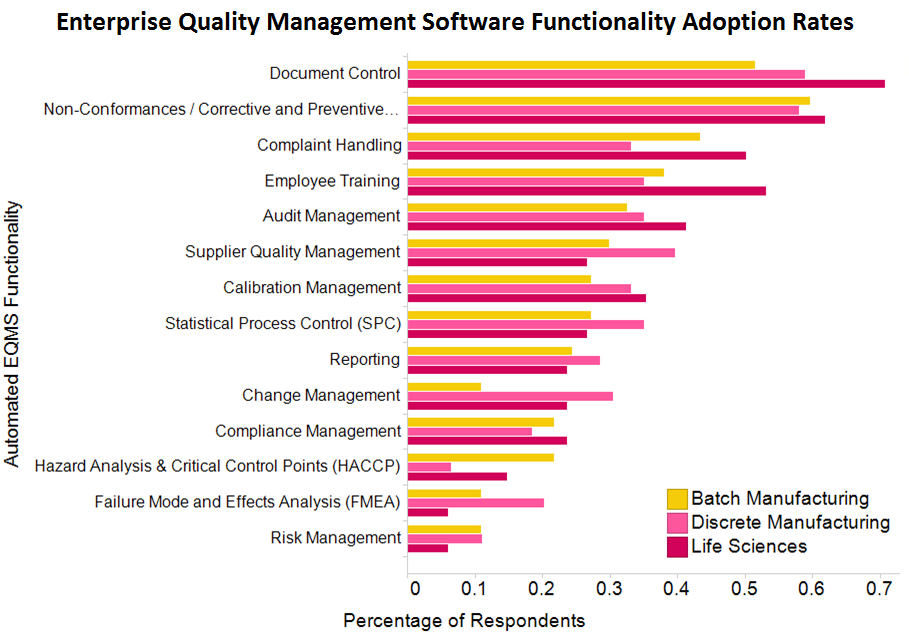“Our IP is what makes us what we are. If this content is not managed in a controlled environment it does not only increase inefficiency but also risk of loss.” That’s what Matt Wickert, Associate Director at Vertex Pharmaceuticals, said at a user conference several months ago. A topic that resonates with many other life sciences quality management and R&D professionals, he was describing his experiences and challenges in 2006 with managing documents in an increasingly regulated and outsourced R&D environment.
Document management, like other enterprise solutions categories, has varying levels of maturity. These tend to range from ad-hoc and as-needed solutions up through comprehensive platforms that build compliance into controlled workflows specific to quality and regulatory content. As those homegrown solutions become increasingly inefficient and unscalable—something that naturally happens in growing companies—quality departments begin the search for a robust document management solution that will meet their needs.
This post looks into the progression many quality management groups go through with document management. It also provides a sneak peek into our newest case study with a leading biotechnology company, Vertex, and several actionable recommendations for executives interested in taking their document management capabilities to the next level.
The Move Away from Ad-Hoc Document Management
Regardless of the industry or company size, organizations are going to have some form of document management system. Because, after all, there’s a great need for creating and controlling documents as well as for being able to easily locate, distribute, and amend them. We’re seeing many companies formalize document management to facilitate the following:
Where differences between companies arise are in the varying stages of document management maturity and needs. Many smaller (and sometimes even larger) companies try to get by with a combination of shared cloud storage space (DropBox, Google Drive, etc.) or local FTP servers and databases.
Others try to use off-the-shelf document management platforms without best practices built in for quality and regulatory content (like SharePoint and Documentum). However, most companies eventually need something more capable and secure.
Where Document Management Software Comes In
Document management software for provides a common platform for improved communication and collaboration. Within these more robust solutions, characteristics that separate them from homegrown solutions generally include:
- Role-based access
- Version control
- Document workflow capabilities (routing, delivery, approval, escalation, etc.)
It is important to note that some solutions, however, go above and beyond just enabling communication and collaboration, and are developed specifically to handle quality and regulated content. These deliver modernized layers of automation and security for industries where data security and regulations are top-of-mind issues, like life sciences, food and beverage, automotive, and A&D.
Document Management at the Enterprise Level
Today, document management capabilities for quality and regulatory content are offered by many Enterprise Quality Management Software (EQMS) vendors as well as some focused Enterprise Content Management players. In fact, as Matthew Littlefield explained in his post on the different types of EQMS solutions providers, some have actually built their platform with document management as the foundation.
In this case, every other module is interconnected with document management—and for good reason—because the ability to easily communicate and collaborate on documents and share information is critical to closed-loop quality processes.
When Should You Make the Move to Document Management Software?
We’re seeing two different approaches to document management software, and quality management software adoption in general. Some companies are adopting entire EQMS suites, rolling out capabilities like NC/CAPA, document management, audit management, supplier quality management, and more simultaneously. While other companies are following more of a best-of-breed approach, deploying one or two EQMS functionalities and then additional ones as value is shown and budget permits, where process automation and document management maybe on separate but integrated solutions.
Data from our recent quality management survey helps visualize which EQMS functionalities and modules are being deployed the most by today’s organizations. As shown, for both discrete manufacturers and life sciences organizations, document management software had the highest adoption rates. For batch manufacturing, NC/CAPA was the most adopted, but document management wasn’t far behind.

In the Real-World: Vertex’s Document Management Journey
For Vertex, where time-to-market and regulatory compliance are of the utmost importance, its R&D department’s needs were outpacing its homegrown document management solution’s capabilities. This case study zeroes in on the challenges Vertex faced with document management and how the organization overcame those challenges with the adoption of an EQMS solution. It focuses on the following:
- Collaborating in today's regulated life sciences environment
- The complexities that drove the need for a better document management solution
- Challenges with document management solution selection
- The benefits of being an early adopter of emerging solution functionalities
- Getting more out of supplier and partner relationships with document management
- Improvements experienced in efficiency, risk, and interactions
If you’re in the life sciences industry, or another industry where data security and compliance are top-of-mind issues, it’s likely that Vertex’s story resonates with you. To read the full case study, and to learn more about the benefits of next-generation document management solutions, follow to button below. You might also be interested in attending a webinar we're participating in with FDAnews on May 13. The webinar focuses on moving past traditional approaches to collaboration. More information can be found here.